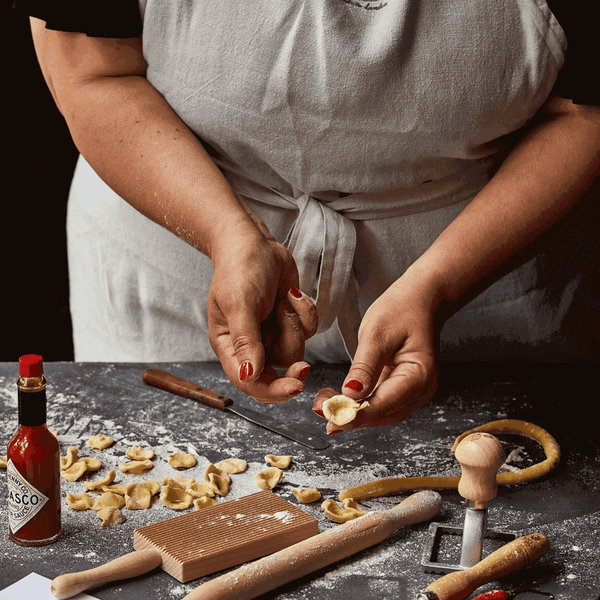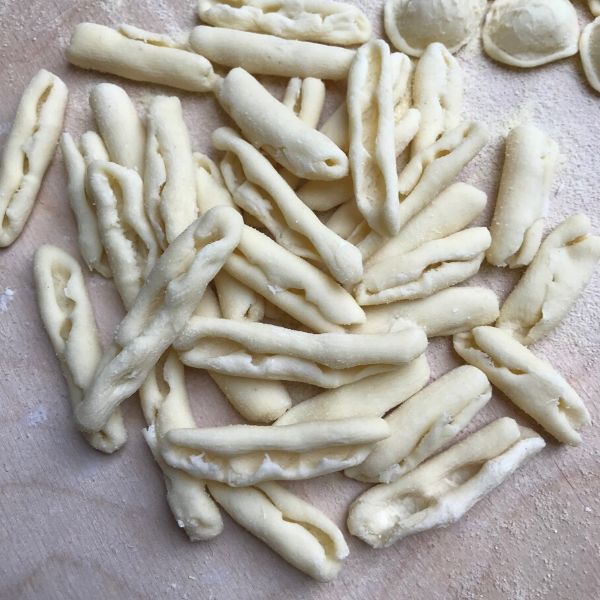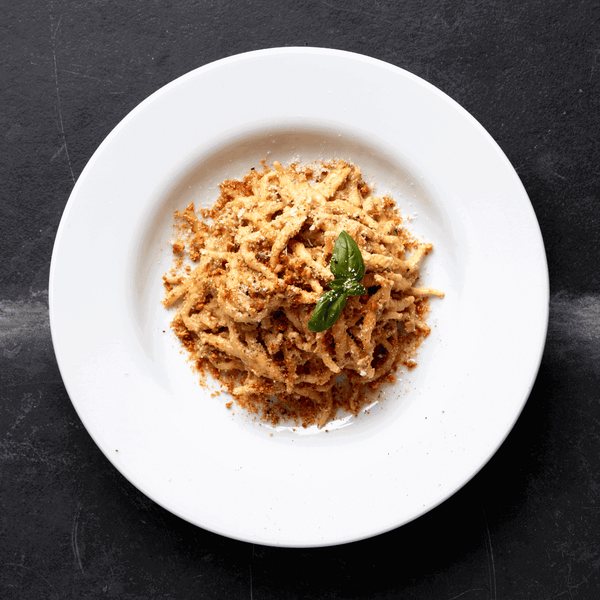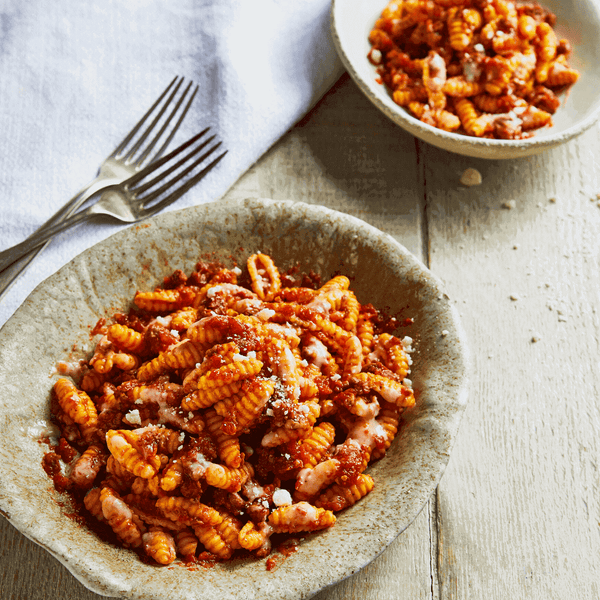How to Make Fresh Vegan Pasta
: invalid url input)
Although the rising popularity of vegan dishes may appear to be a fairly modern phenomenon, vegan fresh pasta has actually existed in Italy for centuries. The traditional recipe alla bolognese for the majority of fresh pasta shapes calls for ‘00’ flour and eggs. However, many pasta shapes are made from what is known as pasta bianca, or “white dough”, made using only flour and water.
These pasta shapes commonly derive from the South, where limited access to expensive ingredients such as eggs meant that pasta-makers had to innovate with the ingredients that they had. Nowadays, pasta bianca remains a popular choice in southern Italy, where a lighter dough is better suited to its warmer climate.
Which pasta is vegan?
Well, technically any shape can be made vegan when made with white dough. To help you get started, we’ve listed our top 4 traditional vegan shapes - all of which can be made at home.
Ever wondered how to make your own vegan pasta? Take a look at our vegan pasta dough recipe, provided by our expert Italian chefs. You can also follow along as our chef Roberta makes vegan pasta dough in the following video.
Our fresh vegan pasta recipe
Serves: 2-3 people
Prep time: 45 minutes
Cooking time: 10 minutes
Calories: 232 kcal per serving (excludes sauce)
Ingredients:
- 200g semolina flour or durum wheat flour, finely ground
- 100ml warm water
- Pinch of salt
Tools:
- Fork
- Wooden board
- Gnocchi paddle, only for malloreddus shape
Method:
Part 1: Making the dough
- On a clean marble or wooden work surface, pile your flour and pinch of salt into a mound.
- Make a well in the centre of the mound large enough to contain the water.
- Gently pour the water into the well.
- Gradually add the flour to the water, slowly incorporating the flour from the sides of the well. As the mixture thickens, start using your hands with a scraper to continue incorporating the flour.
Part 2: Knead the dough
- Clean the work surface of any excess flour or dough bits that never incorporated. Then lightly flour your clean work surface.
- Knead the dough by pressing the heel of one hand into the ball, keeping your fingers high.
- Press down on the dough while pushing it firmly away from you. The dough should stretch and roll under your hand to create a shell-like shape.
- Turn the dough over, then press into the dough with your knuckles, one hand at a time. Continue kneading for about 10 minutes, or until the dough is smooth and springy to the touch.
- Roll the dough into a smooth ball.
Part 3: Let the dough rest
- Place the dough in a small bowl and cover with a cloth or plastic wrap.
- Let the dough rest for 15-20 minutes at room temperature.
Part 4: Shaping your pasta
Now comes the difficult part: you must choose your pasta shape. All of these vegan fresh pasta shapes are ideal for any sauce you choose! We have suggested the traditional sauces that are commonly paired with each shape. However, feel free to explore and innovate.
Part 5: Cooking the Pasta
Chef’s Tip: Save ¼-cup of the pasta water to add to your sauce. The starch and salt in the pasta water adds flavour and helps thicken the sauce.
- Now that your pasta is ready to go, make sure you have your sauce ready and your meal is 5 minutes away!
- Bring a large pot of water to a boil. Once boiling, add a generous amount of salt.
- Add pasta and cook for 3-4 minutes, or until ‘al dente’ (taste a piece before removing from the water). Depending on the shape you decided on, your pasta may need a minute or two longer.
- Strain the pasta and mix with sauce and enjoy!
Our top 4 go-to vegan pasta shapes
Orecchiette
Orecchiette translates to “little ears”, inspired by its shape. This pasta originates from Puglia, a region in southern Italy. A traditional Pugliese dish is orecchiette con cime di rapa, or orecchiette with turnip tops, which is paired with a sauce of garlic, anchovies and chilli flakes.

- To make these little ears, cut off a quarter of the dough and roll into a long sausage shape roughly 1cm in diameter.
- Cut the log into pieces approximately 1cm wide.
- Using a straight-edged knife, press the flat end of the blade down onto the dough and drag this towards yourself, causing the dough to curl over the knife. The pasta should naturally turn outwards with the knife motion. If you are having difficulty getting the orecchiette quite right, feel free to fold them over your thumb to get the distinctive ear-like shape.
- If you are feeling like a pro, you can combine the two above steps by cutting a piece from the log and dragging the knife blade across the dough piece in one swift motion.
- For full instructions, check out - How to make Orecchiette pasta - a simple guide or follow the video below as our chef Roberta makes orecchiette.
Strascinati
The name strascinati derives from the word strascinare, meaning “to drag”, inspired by the process of dragging pieces of dough over a knife to create its shape. This pasta is commonly found in Basilicata in Southern Italy, and has a distinct olive leaf shape. A traditional dish from Basilicata is strascinati con la menta or strascinati with mint. This dish is generally made with olive oil, lard, mint, and garlic. Once again, feel free to try other sauces with this shape (or omit the lard for a vegan-friendly dish).

-
The process of making this pasta shape is very similar to that of orecchiette, except you use your fingers rather than a knife to create a larger shape.
- After rolling the dough into logs, cut the dough into roughly 2cm pieces.
- Using two or three fingers, drag the dough towards you, creating indentations and making the pasta into an olive leaf shape.
Trofie
Trofie originates from the Liguria region of Italy, and is traditionally paired with fresh basil pesto. It is believed the name trofie derives from the Ligurian word strufuggia, meaning “to rub.” This name can be attributed to the process of rubbing the dough against a wooden board to create the distinctive twirls of this shape.
- To make trofie, cut a section of the dough and roll into a thin sausage shape approximately 5mm thick.
- Cut the dough into 2-3cm pieces. Then, take each piece and, using your palm, quickly roll it away from you diagonally on a wooden board. The trofie should start at the centre of your palm and get rolled to the outside of your palm. This motion will create a delicate spiral in the pasta. If you are having difficulty with this motion, you can also roll the pasta down the base of your palm to your fingertips.
- For full instructions, follow the video below as our chef Roberta makes trofie:
Malloreddus | Gnocchetti Sardi
Malloreddus originates from Sardinia, an island off the western coast of Italy, and translates to “fat little bulls” in the local dialect. This shape is also known as gnocchetti sardi or Sardinian small gnocchi. In Sardinia this pasta shape is so revered, it is a tradition for newlywed brides to carry a basket of homemade malloreddus in a basket to her husband’s door. This pasta will then be shared on a single plate to cement their union as husband and wife. While this shape is traditionally paired with a sausage ragù, malloreddus also marries wonderfully with a simple tomato and basil sauce.

- To make malloreddus, begin by rolling the dough into a sausage shape and cutting off into 1cm chunks.
- Using a gnocchi paddle, roll the pieces over the paddle to impress the ridges onto the dough. If you do not have a gnocchi paddle, you can use a fork to impress the ridges onto the dough.







